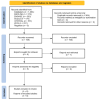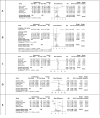Effect of Compression Rotation Intervals on Cardiopulmonary Resuscitation Quality: A Systematic Review and Meta-Analysis
- PMID: 40727595
- PMCID: PMC12303410
- DOI: 10.22037/aaemj.v13i1.2704
Effect of Compression Rotation Intervals on Cardiopulmonary Resuscitation Quality: A Systematic Review and Meta-Analysis
Abstract
Introduction: Reducing the compression rotation interval from 2 to 1 minute is expected to improve cardiopulmonary resuscitation (CPR) quality. This meta-analysis aimed to assess the effect of altering the compression rotation interval on key CPR quality parameters, including compression depth, rate, and rescuer fatigue.
Methods: We systematically searched MEDLINE, EMBASE, Scopus, Google Scholar, Web of Science, and the Cochrane Controlled Register of Trials from their inception to May 15, 2025. We searched for randomized controlled trials, simulation studies, and crossover studies that compared 1-min and 2-min compression rotation times. The assessed outcomes included compression depth, rate, correctness, and rescuer fatigue, which were reported as the standard mean difference (SMD) with a 95% confidence interval (95% CI).
Results: One randomized controlled trial and seven randomized crossover studies, involving 668 rescuers in total, using manikins, were included. The 1-min rotation group exhibited significantly greater compression depth, with an increase of 2.06 mm (SMD = 2.06, 95% CI: 0.44-3.68, p < 0.001). This group demonstrated lower levels of fatigue, as indicated by a significant reduction on the visual analog scale for fatigue (SMD = -1.27, 95% CI: -2.24 to -0.30, p < 0.001). However, there were no significant differences in the compression rate or percentage of compressions that achieved adequate depth.
Conclusion: It seems that altering the chest compression rotation interval from 2 min to 1 min improves the compression depth and reduces rescuer fatigue. However, parameters, such as the compression rate and compression adequacy, remained unchanged. Notably, all the studies were conducted on manikins, thus necessitating further research to assess the applicability of these changes in real-world clinical settings.
Keywords: Cardiopulmonary Resuscitation; Heart Arrest; Heart Massage; Task Performance and Analysis; Time Factors.
Conflict of interest statement
The authors declare that they have no competing interests
Figures




Similar articles
-
Continuous chest compression versus interrupted chest compression for cardiopulmonary resuscitation of non-asphyxial out-of-hospital cardiac arrest.Cochrane Database Syst Rev. 2017 Mar 27;3(3):CD010134. doi: 10.1002/14651858.CD010134.pub2. Cochrane Database Syst Rev. 2017. PMID: 28349529 Free PMC article.
-
Educational interventions for the management of cancer-related fatigue in adults.Cochrane Database Syst Rev. 2016 Nov 24;11(11):CD008144. doi: 10.1002/14651858.CD008144.pub2. Cochrane Database Syst Rev. 2016. PMID: 27883365 Free PMC article.
-
Music interventions for improving psychological and physical outcomes in people with cancer.Cochrane Database Syst Rev. 2021 Oct 12;10(10):CD006911. doi: 10.1002/14651858.CD006911.pub4. Cochrane Database Syst Rev. 2021. PMID: 34637527 Free PMC article.
-
Systemic pharmacological treatments for chronic plaque psoriasis: a network meta-analysis.Cochrane Database Syst Rev. 2021 Apr 19;4(4):CD011535. doi: 10.1002/14651858.CD011535.pub4. Cochrane Database Syst Rev. 2021. Update in: Cochrane Database Syst Rev. 2022 May 23;5:CD011535. doi: 10.1002/14651858.CD011535.pub5. PMID: 33871055 Free PMC article. Updated.
-
Physical exercise training interventions for children and young adults during and after treatment for childhood cancer.Cochrane Database Syst Rev. 2016 Mar 31;3(3):CD008796. doi: 10.1002/14651858.CD008796.pub3. Cochrane Database Syst Rev. 2016. PMID: 27030386 Free PMC article.
References
-
- Talikowska M, Tohira H, Finn J. Cardiopulmonary resuscitation quality and patient survival outcome in cardiac arrest: A systematic review and meta-analysis. Resuscitation. 2015;96:66–77. - PubMed
-
- McDonald CH, Heggie J, Jones CM, Thorne CJ, Hulme J. Rescuer fatigue under the 2010 ERC guidelines, and its effect on cardiopulmonary resuscitation (CPR) performance. Emerg Med J. 2013;30(8):623–7. - PubMed
-
- Hightower D, Thomas SH, Stone CK, Dunn K, March JA. Decay in quality of closed-chest compressions over time. Ann Emerg Med. 1995;26(3):300–3. - PubMed
Publication types
LinkOut - more resources
Full Text Sources
